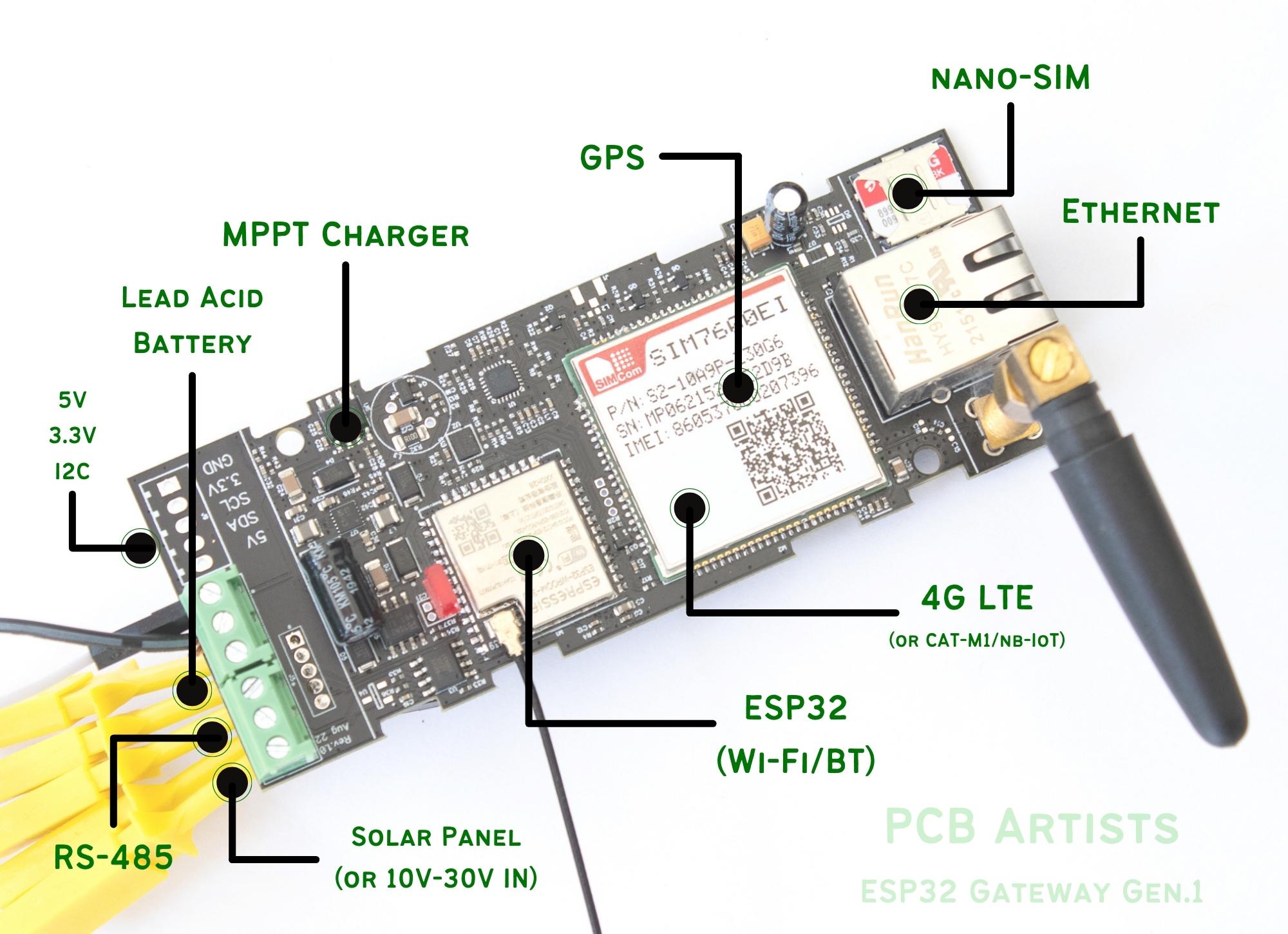
ESP32 4G Gateway Features
Here is a short, definitive list of features that have been packed into this 4G gateway.
- Connectivity (wireless)
– 2.4 GHz Wi-Fi
– Bluetooth 4.0
– 4G LTE (CAT-1), 10 mbps download
– 2G or GSM fallback
– GNSS for positioning (3m accuracy) - Connectivity (wired)
– Ethernet, 100 mbps link
– RS-485, up to 10 Mbps
– I2C for sensors - Power Sources and Specifications
– DC Power (10V – 30V, 2 amps peak)
– (optional) Lead acid battery, 12V, 7Ah or larger
– (optional) Solar panel, V(oc) > 15V, P(max) > 5W
– (optional) Passive PoE (12V or 24V, >12W) - Power Output
– 5V 250mA
– 3.3V 250mA
- Wi-Fi / Bluetooth
– ESP32-WROOM-32 module with u.FL antenna (4MB flash) - 4G LTE + GNSS
– SIM7600 module, prototypes are tested with SIM7600IE
– nano SIM connector - Ethernet
– ESP32 ethernet PHY with Microchip LAN8720
Here is a more detailed walkthrough of the features that we have on the prototype, notes on what can be customized/improved and support resources that will be available for the PCB Artists ESP32 cell modem Gateway.
Want to try this product?
We are expecting a fresh batch of second revision of prototypes before first week of March 2023.
Would you like to get some of them for testing?
If you fill this form up, we will ensure you can get your units first!
ESP32 for Wi-Fi and Bluetooth
The ESP32 4G Gateway, of course, has an ESP32 on board. The current prototype uses an ESP32-WROOM-UE (4 MB) module that allows the user to connect an external IPEX antenna using the u.FL connector.
Future plans do include upgrading to an ESP32-S3 based module ot make use of additional GPIOs available on that chip. The gateway uses almost all of the ESP32 GPIOs at the moment to interface to these peripherals:
- LAN8720 based ethernet connections (can change or upgrade to W5500 for saving ethernet PHY pins)
- SIM7600 modem connections
- RS485 interface connections
- I2C pins for interfacing the gateway to I2C sensors
- Misc analog inputs to detect voltage rail levels, LED for debugging, etc
Ethernet based on LAN8720 (with PoE)
The first generation 4G gateway devices will have a LAN8720 based ethernet interface. LAN8720 uses the ESP32 internal RMII PHY. The 50 MHz reference clock for ethernet is being supplied by an extermal oscillator IC. The design uses something pretty much exactly the same as documented in my article on ESP32 LAN8720 ethernet schematic design.
A design like this ensures full firmware compatibility with ESP-IDF ethernet examples, PlatformIO and ESP32 Arduino libraries.
Passive PoE (power over ethernet)
The ethernet jack that enables data connection for the ESP32 4G gateway also allows PoE. To keep cost low and still allow for power over ethernet, I chose a passive power-over-ethernet solution where the user can feed 24V using a passive PoE injector and power the system using just that.
A previous article on passive PoE schematic design covers the basic idea of passive PoE. This design uses a very similar approach for getting power over ethernet.
Newer generations of the gateway could have 802.3af or 802.3at active PoE.
4G LTE Modem - Simcom SIM7600
Simcom modems were a very favorable choice for us given their popularity, steady stocking and availability and operation across the globe. It makes sense to have an A7670 based ESP32 gateway in the future for cost-sensitive markets like India and Asian countries. However, for now, because North American countries require PTCRB certification for cell modems and SIM7600 is the only low-cost AT&T + Verizon approved modem, we selected the SIM7600.
SIM7600NA is certified by PTCRB for use in North America.
The ESP32 is connected to the SIM7600 using schematics very similar to what is demonstrated in this older article on interfacing a 4G modem with ESP32.
RS-485 for Modbus
The ESP32 4G gateway features an ESD-protected, 5V logic level, 10Mbps RS-485 link to let users connect modbus devices to the gateway. The gateway can act as a modbus device or master, as required.
Because the gateway has both ethernet and RS-485, in addition to Wi-Fi and 4G cellular data, it can act as a communication and control gateway that combines modbus over RS-485 and modbus over TCP/IP via ethernet. This allows you to connect almost any PLC or automation device to the ESP32 gateway.
Solar Panel or DC Power Input
The device runs off of a primary DC supply of 10V to 30V. This input supply is also used to power a lead acid battery charger that can charge and maintain a 12V lead-acid or SLA backup battery. If no DC supply is available, the user can connect a 19V solar panel and lead acid battery to power the ESP32 gateway.
With DC power, solar panel and a battery charger/manager circuit on board, the Gateway can be powered in almost any situation, be it inside a vehicle or out there on remote agricultural land.
Lead Acid Battery Charger
A lead-acid charge management IC on board manages the charge cycles on a backup 12V lead-acid battery. The charger is based on a switching controller, which results in very high efficiency and low heat when charging the battery from a solar panel.
Future generations of the ESP32 gateway may have chargers that support other battery chemistries such as LiFePO4, NiMH and LiPo.
Feel free to ask away via the Quick Contact form in the sidebar, or leave a comment below.
Change Log
- 1 November 2022
– Initial release - 8 January 2023
– Added a condensed list of features for clarity